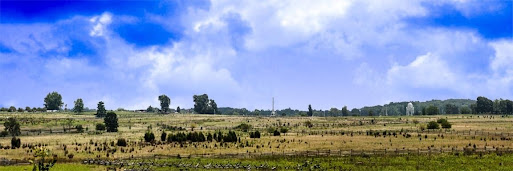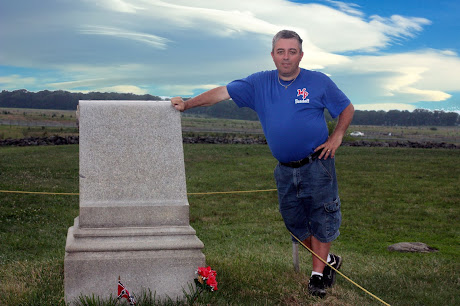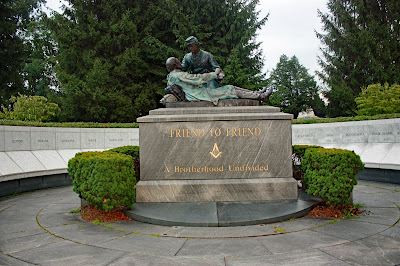Neighbors, brothers, and friends took up arms, not against a familiar foe but against each other. Such were the days of the Civil War. Despite being on opposite sides, the friendship of Lewis Armistead and Winfield Hancock never wavered. Their relationship epitomized the essence of human fellowship.

Lewis Armistead was born February 18, 1817, in New Bern, North Carolina, to parents General Walker Keith and Elizabeth Armistead. Though born in North Carolina, Armistead was a Virginian. His father, a native Virginian, was working on an engineering project in the Chesapeake Bay when He sent his wife to her parent’s home in New Bern, North Carolina, to give birth. Armistead was born in his grandfather’s house. Walker Armistead had bought a farm in Fauquier County, Virginia, where he raised Lewis.
The Armistead family was steeped in military tradition. His father was a veteran of the War of 1812, and his five uncles served in the army. Uncle George Armistead was commander of Fort McHenry during the Battle of Baltimore in the War of 1812. This battle inspired Francis Scott Key to write a poem that would become the National Anthem of the United States. In 1831 he attended Georgetown University in preparation for attending West Point. Lewis Armistead was enrolled as a cadet at the United States Military Academy at West Point in 1834. However, he needed help in his studies. Lewis was not ready for West Point. In twenty-two months, he could not get past his plebe year. After an 1836 altercation with future Confederate general Jubal Early, in which Armistead smashed a mess plate over Early’s head, Armistead was arrested for disorderly conduct. Armistead was now at a crossroads. Despite the incident, he was not dismissed and was not forced to leave; he realized that if he did not resign, he would be court-martialed, and his chances of getting a military commission at any time would disappear.
Armistead’s original class graduated on July 1, 1839. Just nine days later, through the influence of his father and his Uncle Edward Stanly, a United States congressman from North Carolina, Armistead received a direct commission as a second lieutenant with the sixth U. S. Infantry. He served under his father in the Seminole Wars and was soon promoted to first lieutenant. Armistead was assigned to the Sixth Infantry and sent to Oklahoma in 1844. It was here that he first met Winfield Scott Hancock. That same year he also married Cecilia Lee Love. They had two children.
Named for noted War of 1812 commander Winfield Scott, Winfield Scott Hancock was born on February 14, 1824, to parents Benjamin Franklin Hancock and Elizabeth Hoxworth Hancock at Montgomery Square, Pennsylvania, near Philadelphia. The happy parents welcomed Winfield’s identical twin Hilary Baker Hancock into the world. Winfield attended the private Norristown Academy before moving to public school upon its opening. Congressman Joseph Fornance nominated then-sixteen-year-old Winfield to West Point in 1840. Winfield did not set the world on fire academically, graduating eighteenth in a class of twenty-five. This earned him a commission as a second lieutenant in the Sixth Infantry, and he was sent to Oklahoma in 1844. It is here that Hancock met Lewis Armistead. Destined to become close friends, the two men were in different companies of the Sixth.
At the outbreak of the Mexican War, Hancock was assigned as a recruiting officer in Kentucky. Eager to join the fighting, he finally received orders to rejoin the Sixth Infantry in July 1847. This also reunited Hancock with Lewis Armistead. Armistead was the commanding officer of Company F. His two lieutenants were Hancock and future Confederate General Henry Heth. Serving under famed commander Winfield Scott, the two saw each other every day until the Civil War. Hancock was amid the fighting at Contreras and Churubusco (where he was wounded) in August of 1847. His actions earned him a brevet promotion to First Lieutenant. Armistead was wounded at the Battle of Chapultepec and decorated three times for bravery.
Following the Mexican War, Hancock met Almira Russell while stationed in St. Louis. They were wed in 1850 and had two children. Armistead also served near St. Louis, assigned to Jefferson Barracks. Beginning in 1850, however, Armistead experienced a series of unfortunate events that would have broken most men. In April, Armistead’s daughter died of illness. That December, after being transferred to Fort Dodge, his wife Cecilia passed away also. In 1852 his family home was destroyed by fire. Returning to Virginia, he married his second wife, Cornelia Jamison. Cornelia accompanied her husband to several western assignments. The couple had a son who died in December 1854. The following year, Cornelia contracted Cholera and passed away. Despite the setbacks, Armistead persevered. After serving a series of postings in the Kansas and Nebraska Territories, Armistead found himself in Southern California, reunited with Hancock, who had been transferred to the Department of the Pacific, serving as a quartermaster in Los Angeles under future Confederate Major General Albert Sydney Johnston. Also in Southern California were future Generals John Reynolds (U.S.) and Richard Garnett (C.S.).
As tensions grew between north and south, the men remained friends. When the news of Fort Sumter reached the west coast, the friends realized they each had to make a difficult decision. Armistead resigned his commission out of loyalty to his state. Before the friends departed, they gathered in the home of Hancock to say their final farewells. According to Mrs. Hancock, the gathering included six officers who had resigned their commissions, three of whom were destined to die in front of Hancock’s troops during Pickett’s Charge. It was an emotional time for all involved, especially Armistead and Hancock. Armistead gave Mrs. Hancock his prayer book, inscribed inside: “Trust in God and fear nothing.” He also gave her some small personal items to be returned to his family after his death. In addition, Armistead, anticipating Captain Hancock’s promotion, presented his friend with a new Major’s uniform. The next day, the two went their separate ways, Armistead, to Virginia, by way of Texas, and Hancock to Washington, D.C.
Once back in Virginia, Armistead received a commission as a Colonel in the Fifty-Seventh Virginia Infantry. On April 1, 1862, he was elevated to Brigade command in the division of Benjamin Huger. He was a disciplinarian, earning the respect of his men by leading from the front. Armistead distinguished himself at the Battle of Seven Pines and led a courageous charge at the Battle of Malvern Hill. Robert E. Lee, needing a disciplinarian, assigned Armistead to Provost Marshall’s duties during the Maryland Campaign. Thus, Armistead missed the fighting at the Battle of Antietam. His brigade fought gallantly at Fredericksburg and Chancellorsville.
Hancock returned to Washington, expecting to continue his quartermaster duties. However, that September, he ascended to the rank of brigadier general. He was assigned to command a brigade, in the Army of the Potomac Army, under General George McClellan. His star began to rise during the Peninsula Campaign of 1862. During the Battle of Williamsburg, Hancock, at a critical point in the fight, ordered a charge that won the field. In his report, McClellan praised Hancock, saying, “Hancock was superb.” The moniker stuck. Hancock assumed command of the First Division of the Second Corps following the death of General Israel Richardson at the Battle of Antietam. He commanded a division under General Ambrose Burnside at Fredericksburg, receiving a minor wound. Hancock saved the Army of the Potomac from a significant disaster following the Battle of Chancellorsville. His troops protected the rear of the retreating army, buying the needed time to cross the Rappahannock. Second Corps commander Darius Couch praised Hancock’s actions in his after-battle report before resigning in disgust due to the actions (or inactions) of AOP commander Joseph Hooker. Hancock was immediately elevated to command the Second Corps. The stage was now set for the greatest battle ever fought on the North American continent.
The friends finally “met” again on July 3, 1863. Armistead commanded a brigade in the division of General George Pickett in the Army of Northern Virginia. Hancock commanded the Second Corps as well as the left wing of the Army of the Potomac. The day’s battle began at roughly 1:00 PM, as approximately one hundred fifty confederate guns unleashed on the Union position at Cemetery Ridge. When the shelling ended, about twelve thousand Confederate troops emerged from the woods and began a nearly one-mile march across open fields to attack the Union center, aiming for a “copse of trees.”

General Garnett, an easy target on horseback, fell about halfway across the open field. His body was never recovered. Armistead’s brigade, reduced to less than two hundred men, was the only brigade to reach the low stone wall behind which the Union troops waited. He led his men with his hat atop his saber, the colors having fallen. Armistead moved toward the stone wall shouting, “Come on, boys, give them the cold steel!” He fell as he climbed over the stone wall and put his hand on one of Cushing’s abandoned guns. Noted historian James McPherson said, “Armistead was mortally wounded with his hand on a Yankee cannon, and his followers fell like leaves in an autumn wind.”
Meanwhile, during the battle, Hancock encouraged his troops on horseback. One of his staff officers suggested that Hancock move back, so he did not expose himself to the enemy; Hancock turned to him and said, “There are times when a Corps Commander’s life does not count.” Soon after, he was wounded when a minie ball hit the pommel of his saddle and struck his thigh, embedding pieces of wood and metal into the wound.
Union Captain Henry Bingham rendered aid to the fallen Armistead. Armistead asked about his friend General Hancock. When told that Hancock had been wounded, Armistead cried out, “Not both of us on the same day!” He then said to Captain Bingham, “Say to General Hancock for me that I have done him, and you all, a grievous injury, which I shall always regret.” He also asked Bingham to give his personal effects to his longtime friend. The spot where Armistead fell, marked by a small monument, is pictured below. This area has come to be known as “the angle.

Armistead’s wounds were mortal, and he died two days later. New evidence indicates he may not have passed from infection as some believe, but rather a pulmonary embolism. He was carried to the George Spangler farm, the location of the Eleventh Corps hospital. He was buried at Spangler farm when he died. Dug up a month later, his body was topically embalmed, and he was put on a railroad train in a sealed coffin and sent to Baltimore. Today he is buried at the old Saint Paul Cemetery in Baltimore. He was placed in the family crypt near his uncle, the defender of Fort McHenry, George Armistead. Survivors of the 72nd Pennsylvania and the Gettysburg memorial Association erected a marker where he fell in 1888.
After a long recuperation, Hancock returned to his Second Corp command. Now under General Ulysses Grant, Hancock served ably in the Overland Campaign of 1864. Due to continued complications from his Gettysburg wound, Hancock gave up his field command but continued to serve. In July 1865, he was assigned by President Andrew Johnson to take charge of the execution of David Herold, Lewis Powell, George Atzerodt, and Mary Surratt, all convicted in the plot to assassinate President Lincoln. Following the war, Hancock remained in the army.
In 1872, Hancock assumed command of the Division of the Atlantic, succeeding George Meade, a post he would hold for the remainder of his life. He also became involved in politics and was the Democratic candidate for President of the United States in 1880, losing to James Garfield by less than ten thousand votes.
Winfield Scott Hancock died at Governors Island, New York, on February 9, 1886, due to diabetic complications and is buried in Montgomery Cemetery in Norristown, Pennsylvania. In his memoirs, Grant described his admiration of General Hancock:
“Hancock stands the most conspicuous figure of all the general officers who did not exercise a separate command. He commanded a corps longer than any other one, and his name was never mentioned as having committed in battle a blunder for which he was responsible. He was a man of very conspicuous personal appearance. Tall, well-formed, and, at the time of which I now write, young and fresh-looking, he presented an appearance that would attract the attention of an army as he passed. His genial disposition made him friends, and his personal courage and presence with his command in the thickest of the fight won him the confidence of troops serving under him. No matter how hard the fight, the 2d corps always felt their commander was looking after them.”
The Friend memorial commemorates the friendship of Armistead and Hancock to Friend Masonic Memorial at Gettysburg National Military Park. It depicts Captain Bingham rendering aid to the fallen Armistead. From the tablet on the monument:
Friend to Friend
Union General Winfield Scott Hancock and Confederate General Lewis Addison Armistead were personal friends and members of the Masonic Fraternity. Although they had served and fought side by side in the United States army prior to the Civil War, Armistead refused to raise his sword against his fellow Southerners and joined the Confederate Army in 1861. Hancock and Armistead fought heroically in the previous twenty-seven months of the war. They were destined to meet at Gettysburg. During Pickett’s Charge, Armistead led his men gallantly, penetrating Hancock’s line. Ironically, when Armistead was mortally wounded, Hancock was also wounded. Depicted in this sculpture is Union Captain Henry Bingham, a Mason and staff assistant to General Hancock, himself wounded, rendering aid to the fallen Confederate General. Armistead is shown handing his watch and personal effects to be taken to his friend, Union General Hancock. Hancock survived the war and died in 1886. Armistead died at Gettysburg on July 5, 1863. Captain Bingham attained the rank of General and later served 32 years in the United States House of Representatives. He was known as the “Father of the House.” Shown on the wall surrounding this monument are the names of the States whose soldiers fought at the Battle of Gettysburg.

Lewis Armistead and Winfield Hancock did have differences. Armistead could not turn his sword against Virginia. Hancock was steadfast in his loyalty to the Union. Their views, however, never affected their friendship. We could all learn a lot from these men. They respected each other’s views, and despite what their respective governments told them, they did not consider each other enemies.
References
Carraway, Gertrude S. “Armistead, Lewis Addison.” NCpedia. Accessed January 29, 2021. https://www.ncpedia.org/biography/armistead-lewis-addison.
Cawthorne, Nigel. Gettysburg: the Battle for Liberty, Equality and Brotherhood. New York, NY: Chartwell Books, 2015.
Coddington, Edwin B. The Gettysburg Campaign: a Study in Command. New York: Scribner, 1984.
Gragg, Rod. The Illustrated Gettysburg Reader: An Eyewitness History of the Civil War’s Greatest Battle. Washington DC: Regnery Publishing, 2013.
Guelzo, Allen C. Gettysburg: the Last Invasion. New York: Vintage Books, 2014.
Knauer, Kelly. Gettysburg: Turning Point of the Civil War. New York: Time Books, 2013.
McPherson, James. Hallowed Ground: a Walk at Gettysburg. Minneapolis, MN: Zenith Press, 2015.
Motts, Wayne, Lewis Armistead with Special Guest Licensed Battlefield Guide Wayne Motts (S1 E7) September 15, 2019. The Battle of Gettysburg Podcast https://anchor.fm/battleofgettysburgpodcast/episodes/Lewis-Armistead-with-Special-Guest-Licensed-Battlefield-Guide-Wayne-Motts-S1-E7-e58ca7
Rasmussen, Cecelia. “L.A. Friends Faced Each Other at Gettysburg.” Los Angeles Times. Los Angeles Times, June 18, 2000. https://www.latimes.com/archives/la-xpm-2000-jun-18-me-42292-story.html.
The Friendship of General Hancock and Armistead.” The Concordian. Accessed January 29, 2021. http://www.concordianonline.com/news/view.php/1033470/The-Friendship-of-General-Hancock-and-Ar.
Trudeau, Noah Andre. Gettysburg: a Testing of Courage. New York: Perennial, 2003.